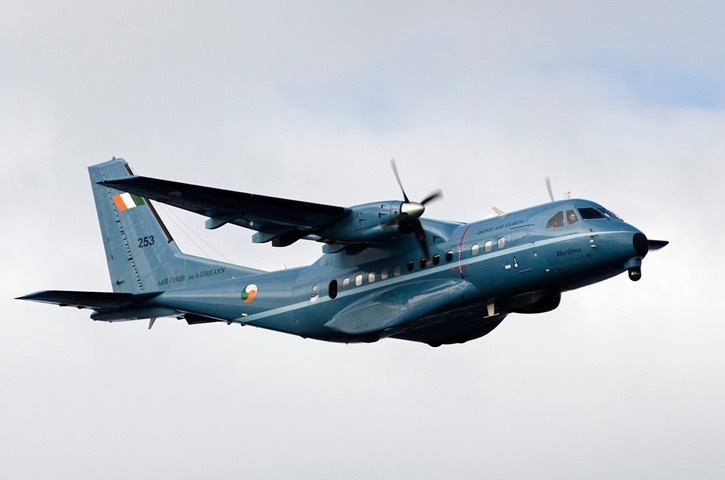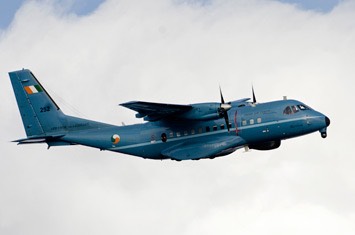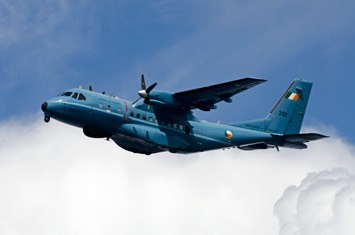Summer and autumn of 2013 saw us heading out to the Porcupine Seabight, southwest of Ireland. It turned out to be an epic voyage - the highlight being large numbers of great whales, including close encounters with majestic blue whales.
July turned out to be the month of the short-beaked common dolphin (Delphinus delphis), which was by far the most abundant species we saw. At times, groups of these acrobatic animals gathered in loose aggregations, forming a pod of several hundred strong, and dolphins could be seen in every direction around the ship.
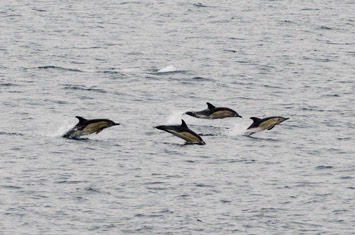
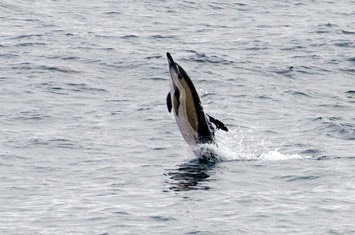
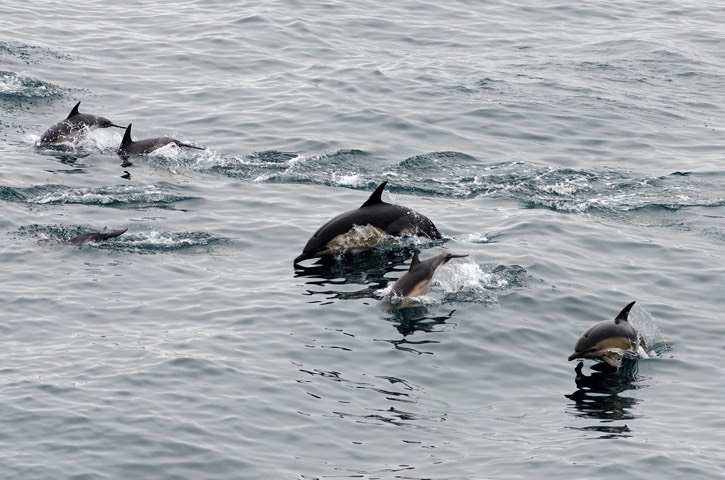
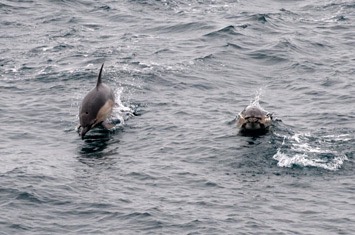
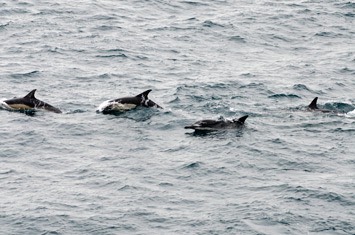
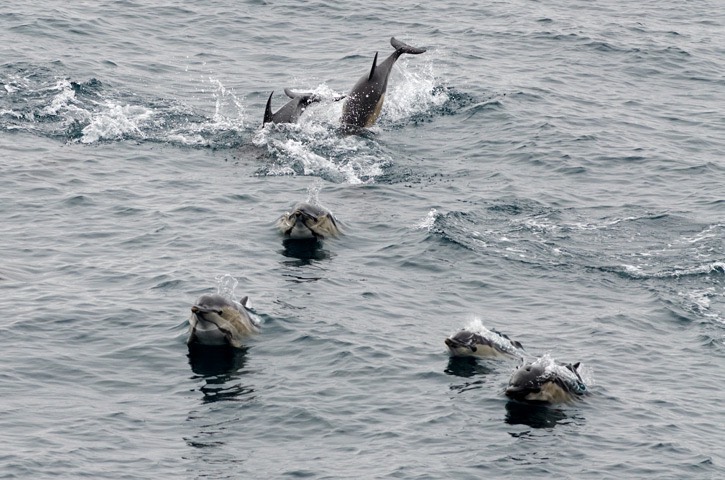
Common dolphins are curious mammals and often raced up to the ship to check us out. Often, lots of dolphins would crowd around the bow to enjoy a free ride in our bow wave.
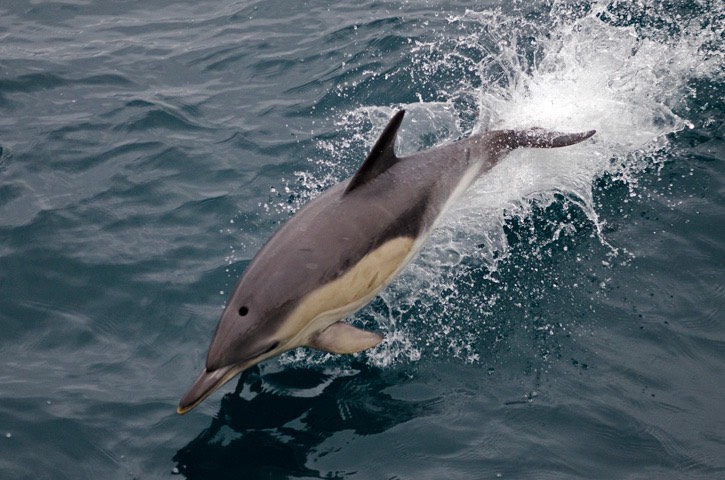
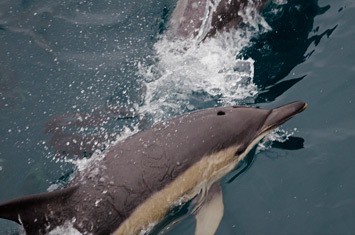
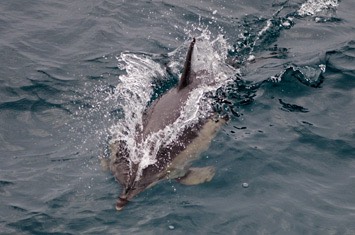
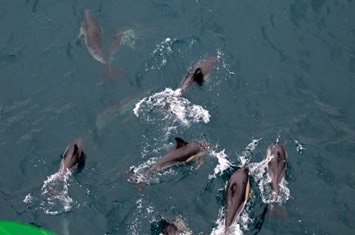
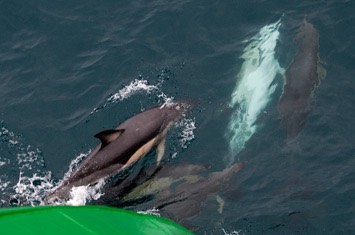
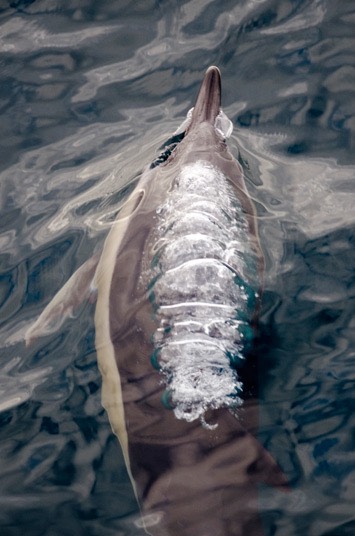
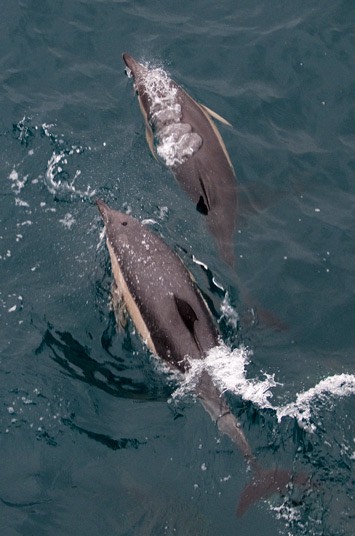
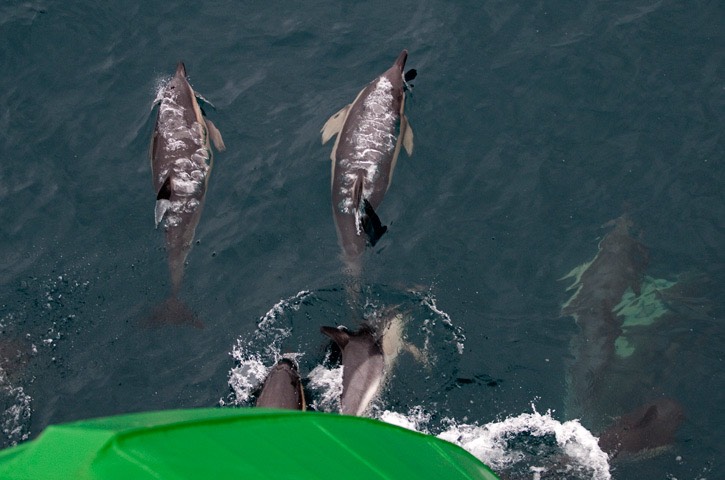
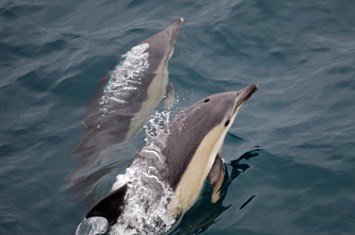
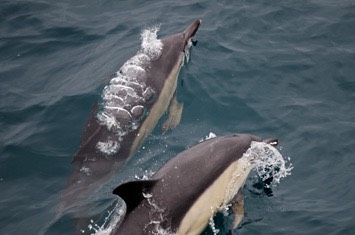
Even the youngsters were keen to come and bow-ride, although usually sticking close to their mums.
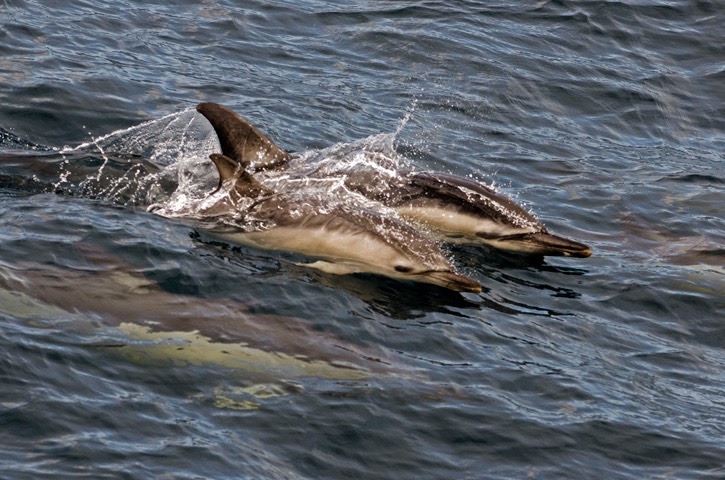
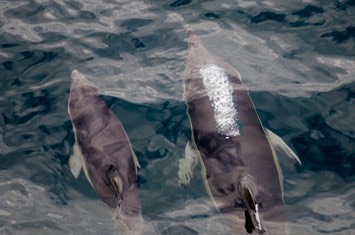
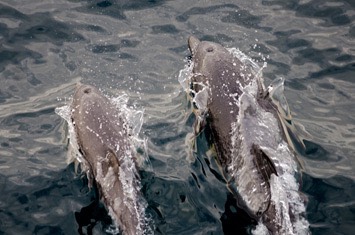
We came across bottlenose dolphins (Tursiops truncatus) less frequently, but when they were seen they were usually in quite large groups, which is typical of the offshore form of this species. Their colour pattern was quite different from those bottlenose dolphins that spend most of their time close to shore around Ireland or the UK, in that they had very pronounced but narrow dark capes. Unfortunately, we didn’t manage to get any good photographs of their dorsal fins, which might have been of use in checking their identities against the photo-identification catalogues of coastal dolphins. Only one group came close to the vessel: they had several young calves with them, which are a much paler grey than the adults. One calf still had foetal folds (vertical stripes down the sides of its body), which are thought to arise from being folded in its mother’s womb and which only disappear when the calf grows older.
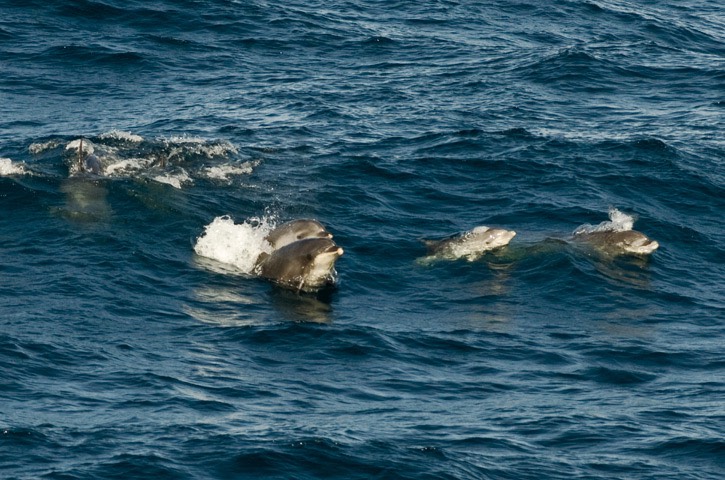
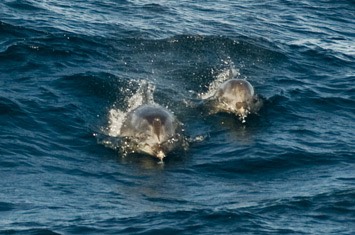
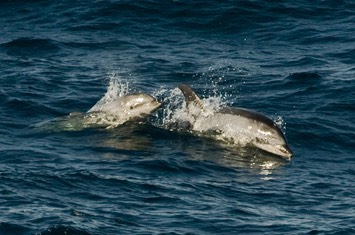
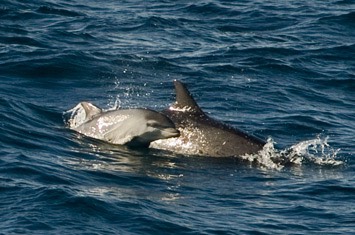
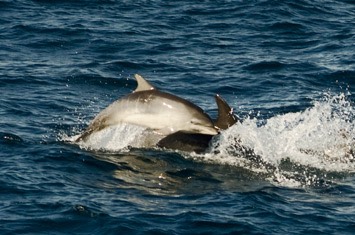
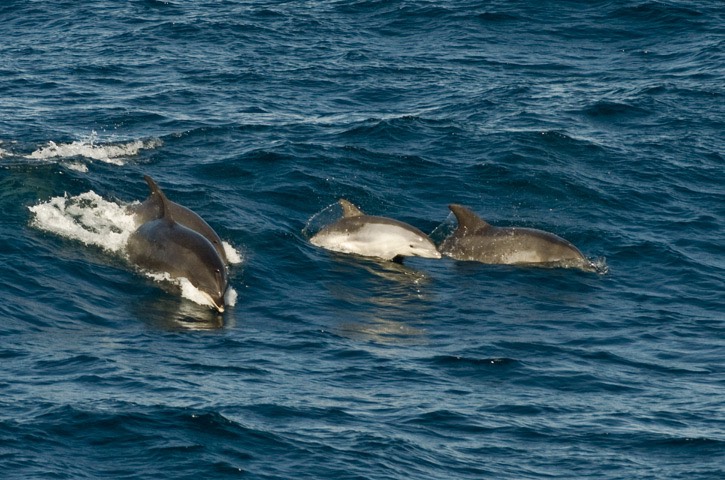
On some sudden cue the whole group turned around and porpoised away at high speed - it was quite a spectacle!
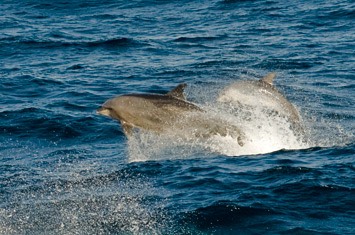
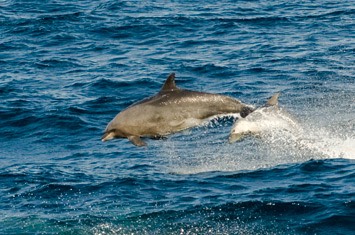
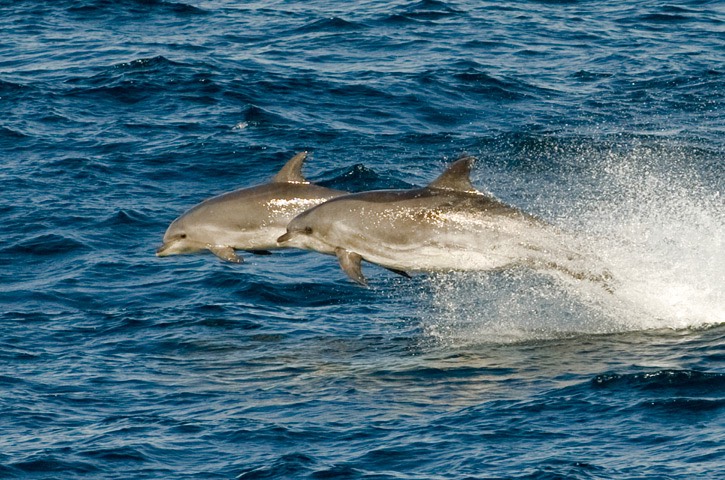
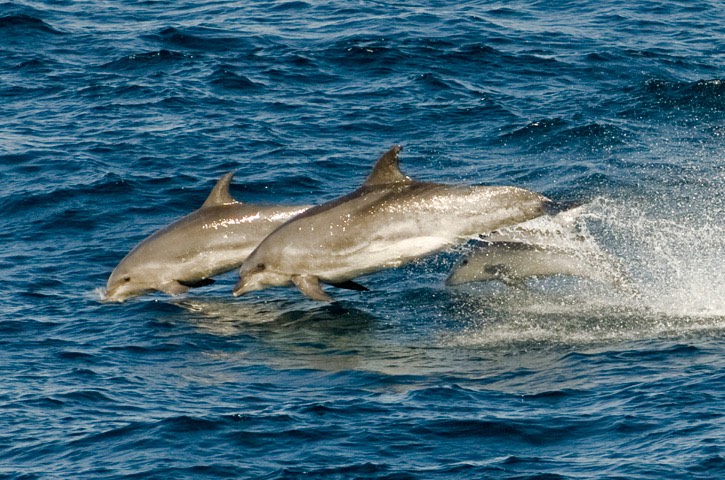
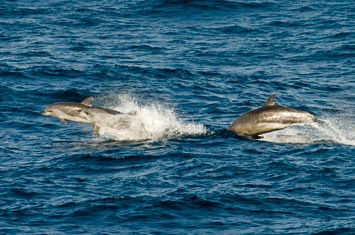
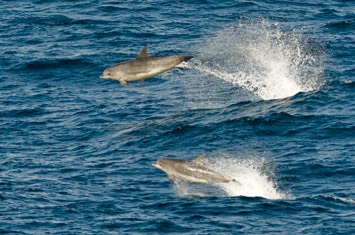
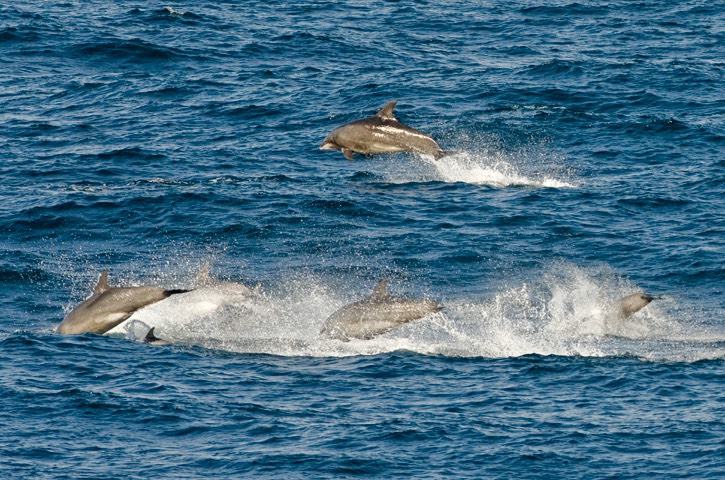
Another species we saw frequently during July was long-finned pilot whale (Globicephala melas). These usually slow-swimming animals often passed us quite close and on more than one occasion we could see that they had tiny, newborn calves with them. Pilot whales sometimes spy-hop, when they stand upright in the water and lift their heads above the surface, showing off their bulbous forehead characteristic of this species.
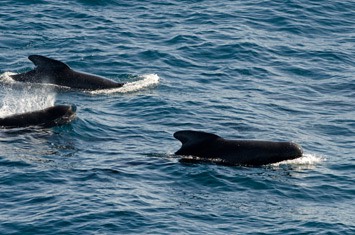
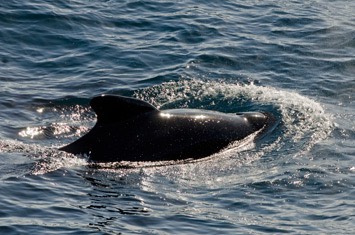
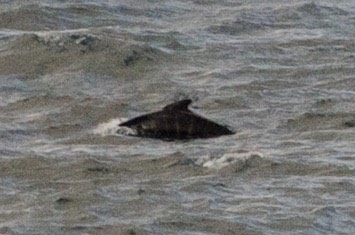
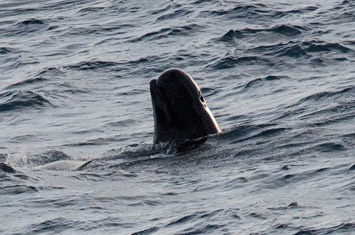
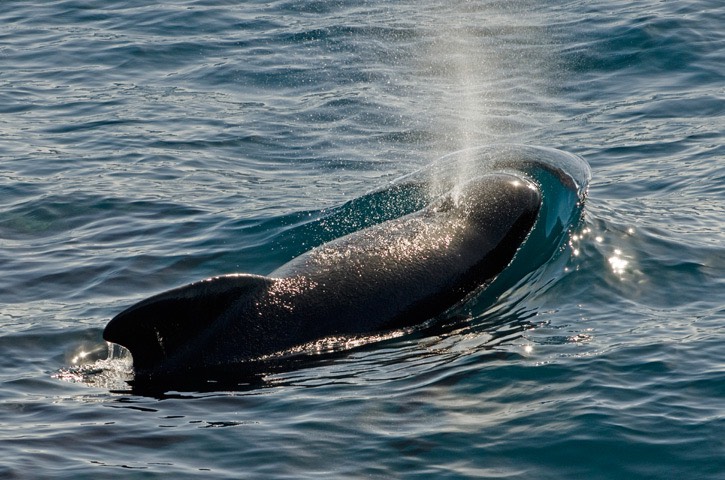
One evening when we were about to call it a day, we saw a group of pilot whales in the distance. As they were heading towards our track line, we decided to wait for them. In the end three subgroups crossed just ahead of our bow and in the low evening light these usually glossy, jet-black animals took on a gorgeous golden-brown colour.

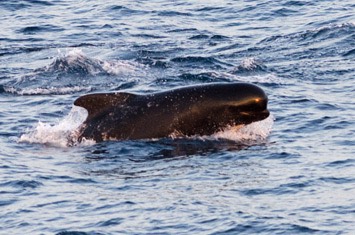
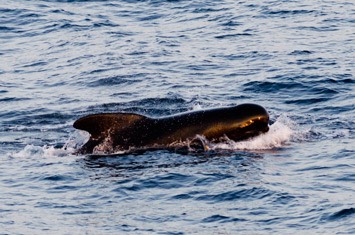
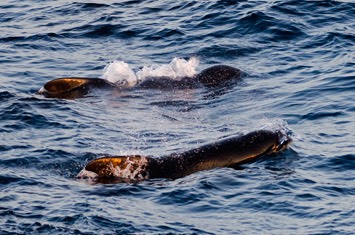
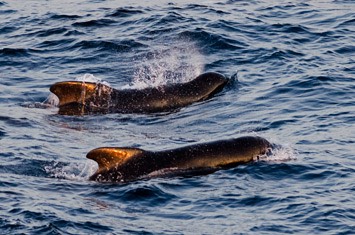
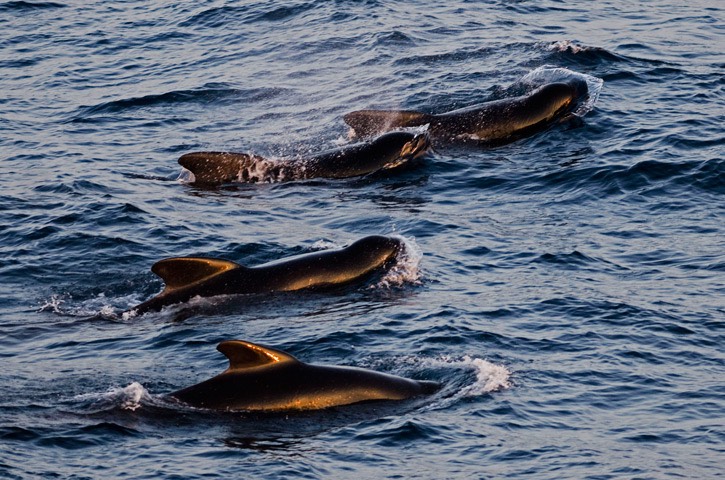
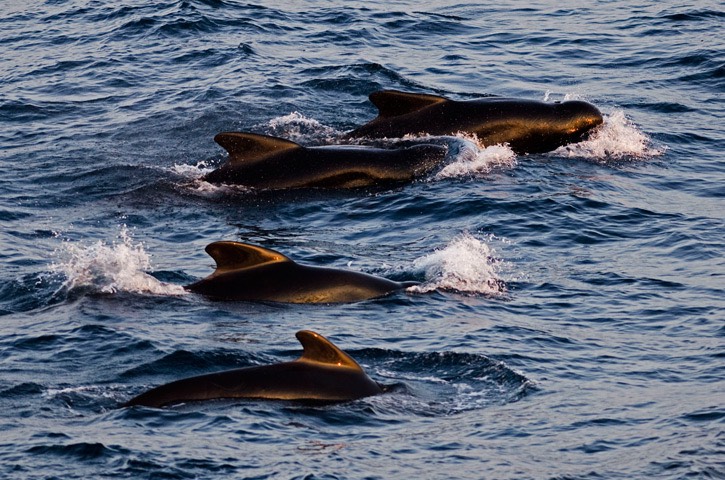
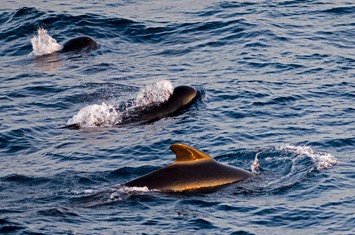
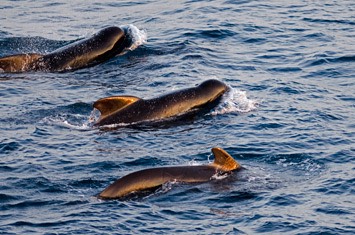
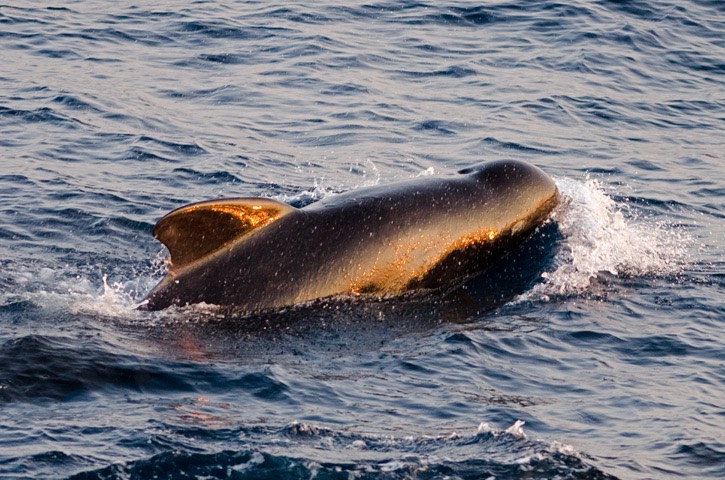
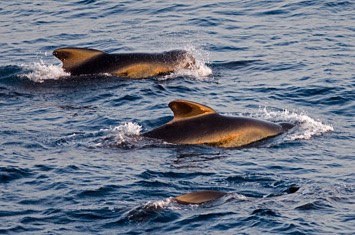
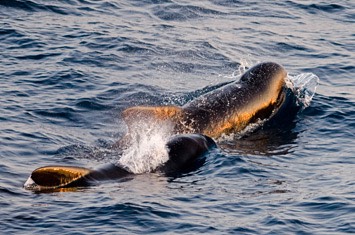
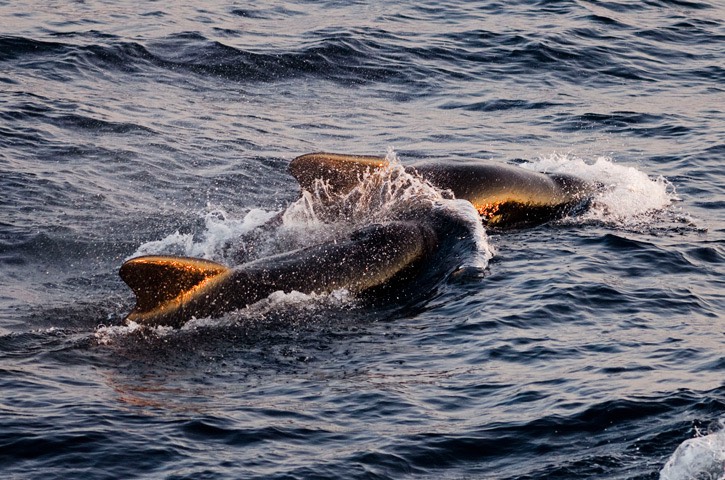
Although we had seen a few fin whales (Balaenoptera physalus) during July, large numbers of these impressive beasts moved into the area during the second half of September and into early October. They were aggregating in the same area that attracts the French and Spanish tuna fishing fleet, as both tuna and the whales feed on the abundant krill. One of our first encounters was with two whales crossing our bow, and swimming leisurely within less than hundred metres of us. Each fin whale has a unique pattern of grey swirls (known as a chevron) on its flanks, which, together with its dorsal fin, can allow the individual identification of whales. The dorsal fins of fin whales are usually quite tall, falcate and with a leading edge swept back at a 45-degree angle, but one of these two whales had a very small, stubby fin.
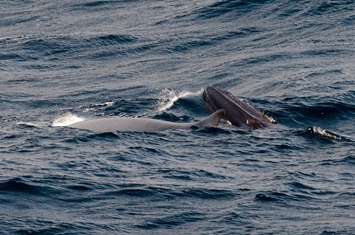
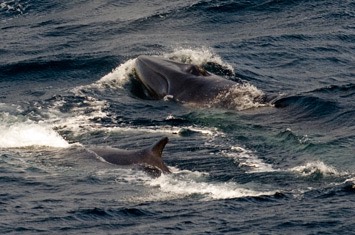
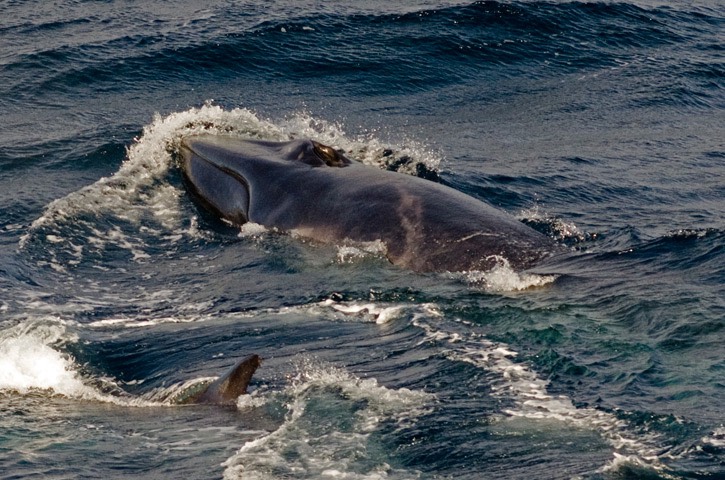
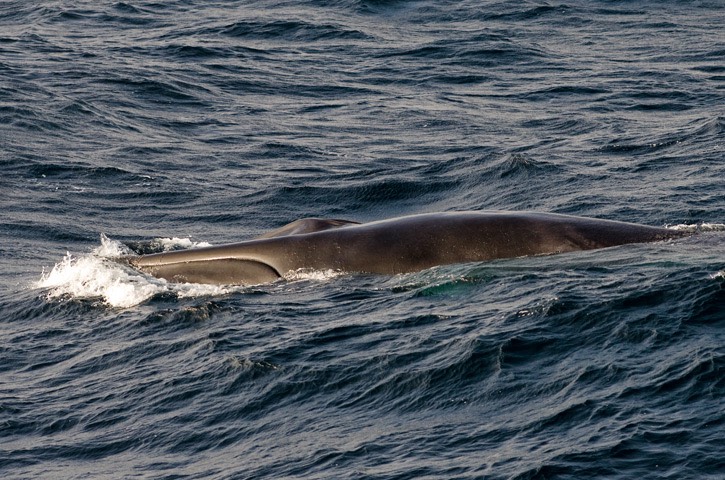
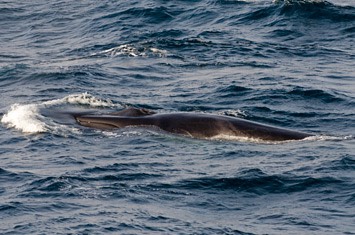
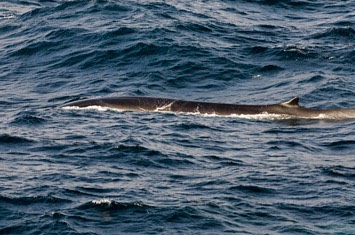
On quite a few occasions we saw two fin whales swimming side by side, being followed by one or more other whales. The whales in pursuit would often swim very fast and surface with large parts of their heads showing above the surface. We since learnt that this behaviour is typically seen during the breeding season, when a male guards a female and other hopeful males turn up in pursuit, clearly trying to impress both the female and the current male of her choice. We generally witnessed this fascinating behaviour at some distance from the vessel, so the photos below are not of the best quality.
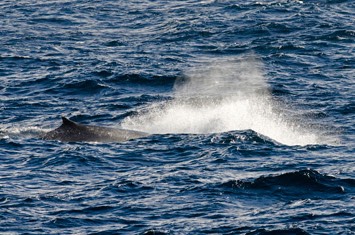
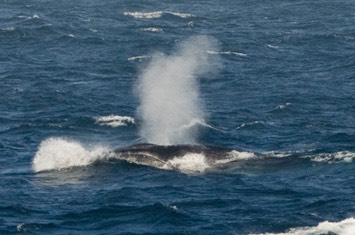
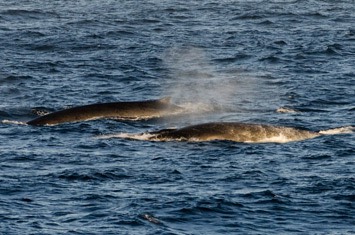
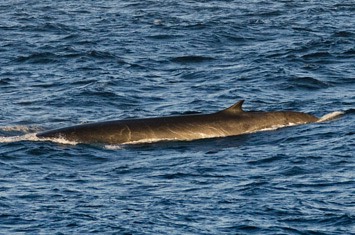
Watching so many of these whales rushing energetically around, apparently displaying aggression towards each other, we commented that it seemed odd that one almost never sees a fin whale breach. Barely a few seconds later, one of the whales half breached and with head and shoulders in the air, turned around to fall back onto its back! This move allowed us to see the white lower right jaw typical of this species.
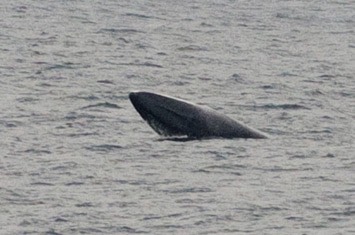
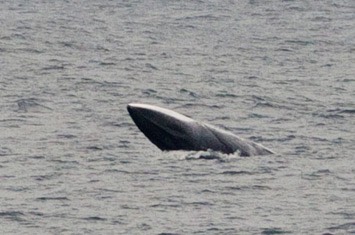
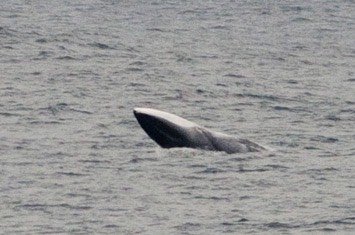
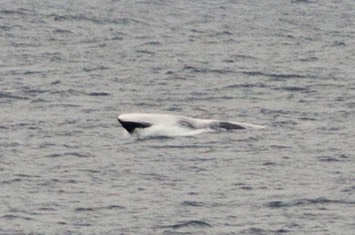
Occasionally we could see smooth round patches on the sea surface, which were made by the tail flukes of whales swimming just below the surface. These so-called footprints are a sure indicator that a whale has managed to sneak up on us! Quite a few times fin whales, the second largest animal in the world, managed to appear right next to the ship, apparently turning up out of nowhere!
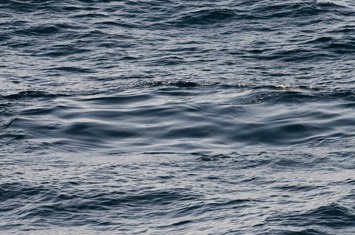
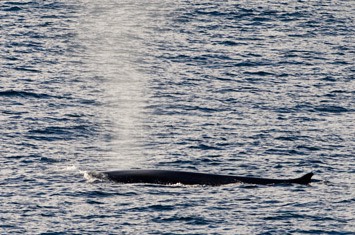
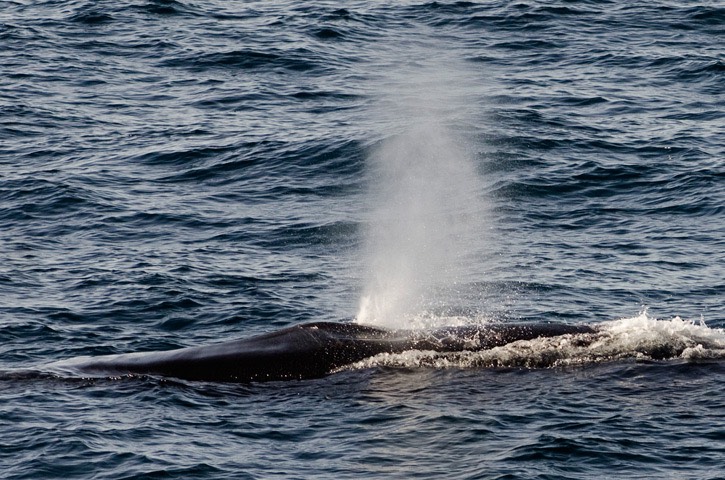
However, it seems that there was a conspiracy against us by the fin whales. We wanted to get a good quality photo of a white lower right jaw, but every whale that came close to the vessel seemed to be showing its left side, or would not raise its head enough if it did go to the right.
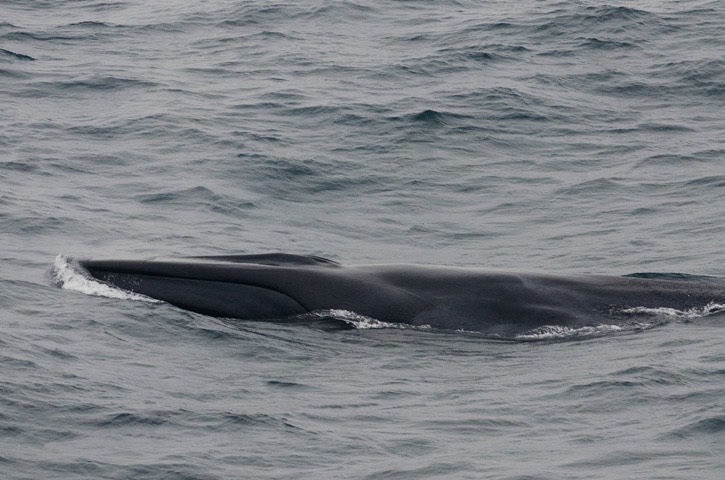
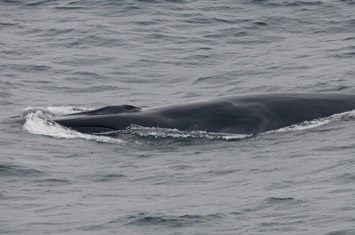
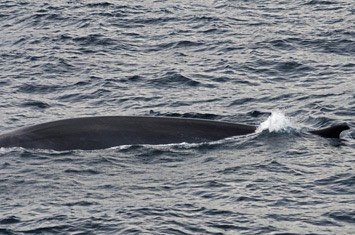
In September the first blue whales (Balaenoptera musculus) turned up, in choppy autumn seas. After the first whale sneaked past us first thing in the morning in poor light, we were treated to two magnificent blue whales that approached the vessel to within a couple of hundred metres. Even compared to fin whales, these were massive animals with huge blows.
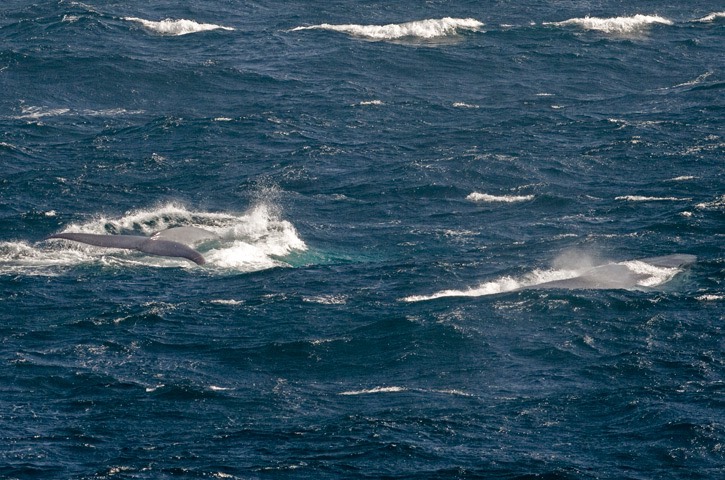
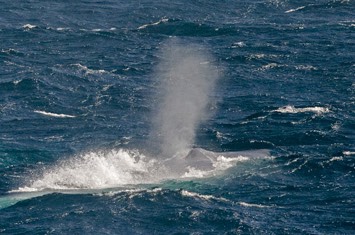
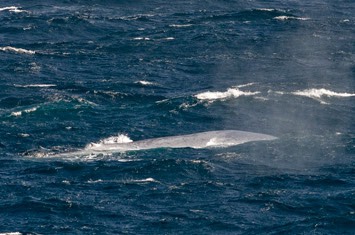
While most other baleen whales are quite dark in colour, blue whales are light grey with irregular patches of paler mottling. The pattern on each whale is unique and this, together with the shape and colouration of their dorsal fins, enables scientists to recognise individuals. For the size of the animal, their dorsal fins are very small; this is the only whale species with such a proportionately tiny fin. The first two photos below show the same individual which has a lot of fine mottling all over the front part of its back, fewer spots under its dorsal fin and a dark tip and trailing edge to its dorsal fin. The third photo shows the second individual, which has little spotting behind the blowhole, bigger splotches all over its back and a very small pale dorsal fin.
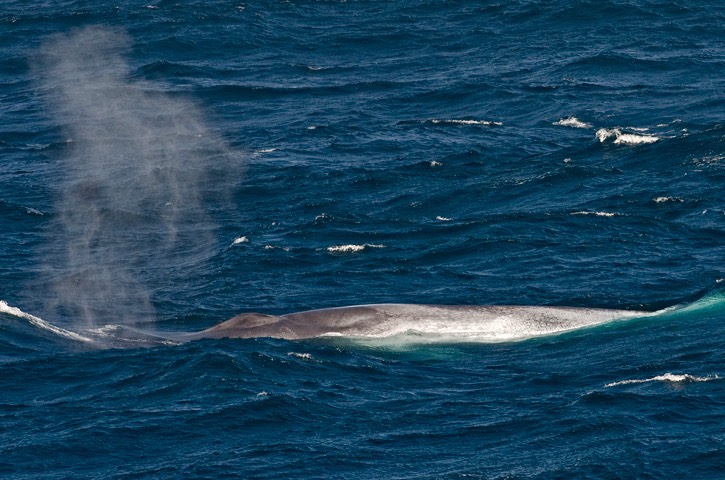


Over the next few days we were treated to several more blue whale sightings, albeit not so close to the ship. Our photos nevertheless showed that all these whales were different individuals, like the one below, which was very pale and had a missing tip to its very dark dorsal fin.
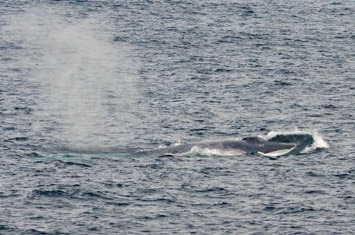
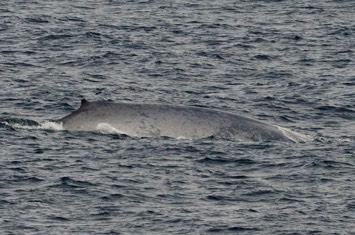
On one occasion while watching a blue whale cross ahead of our vessel (the whale on the left in the photos below), we saw that a fin whale was heading towards it from the opposite direction. We wondered if there would be any reaction when the two whales met, but they passed within a few metres of each other and continued on their respective ways.


Another blue whale treated us (and the rest of the crew) to a very special sighting. It appeared out of nowhere on a rather choppy, foggy day, and some of the photos below show how even such a huge animal blends in with the grey waters of the North Atlantic! Although blue whales may not necessarily appear all that pale when they are on the surface, their bodies show as a ghostly pale blue patch under the surface of the sea, which makes it easier to track the submerged animal. This individual didn’t seem to be of fully adult size but it gave us a good impression of its massive bulk by showing both the blowholes and its tiny dorsal fin, which is located very near the tail flukes.


It took us a while to figure out what was going on when we saw the whale wave both its flipper and part of its tail fluke above the surface. In fact the whale was feeding and had rolled on its side to gulp big mouthfuls of prey. We could even see its distended throat on a couple of occasions and in one photo the whale’s eye was visible, too! The underside of the flippers of this whale was a pure white, while the upper side was mainly dark grey with a white tip and some pale grey blotches.

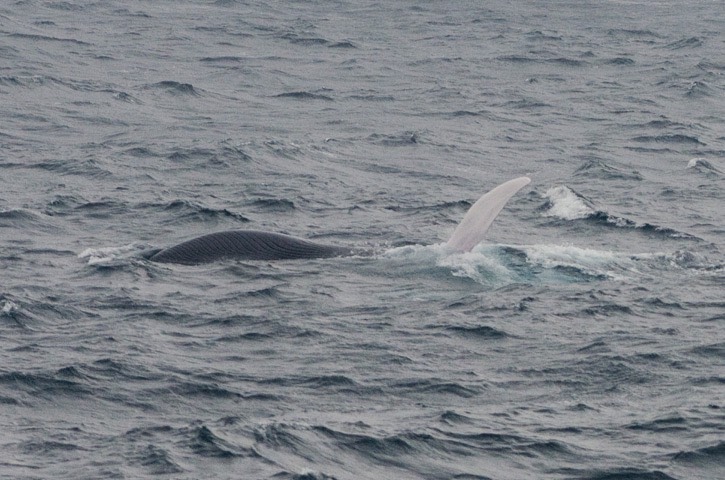
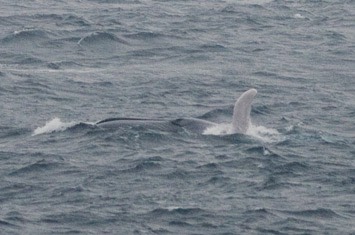
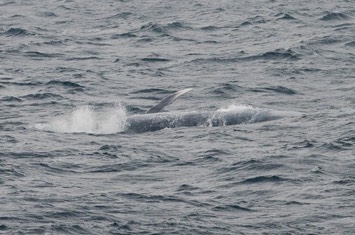
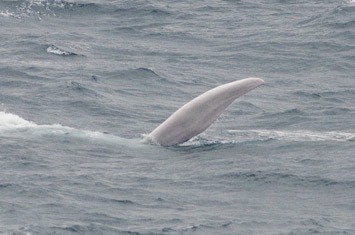
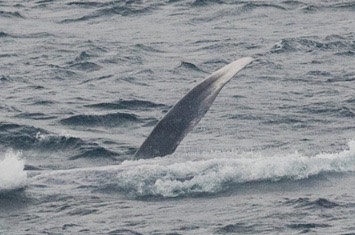
Even the close presence of the vessel didn’t seem to disturb the whale and it continued to make lunges on its side close to the surface. The photos below show the whale halfway on its side, looking on the top of its rostrum with the central ridge running down the middle.
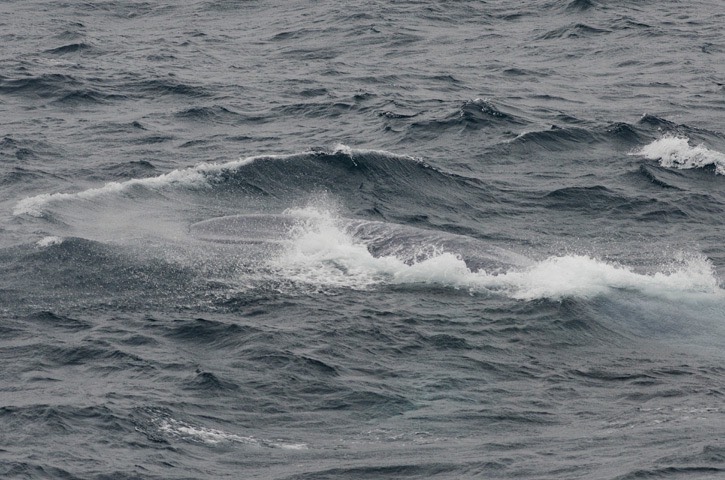
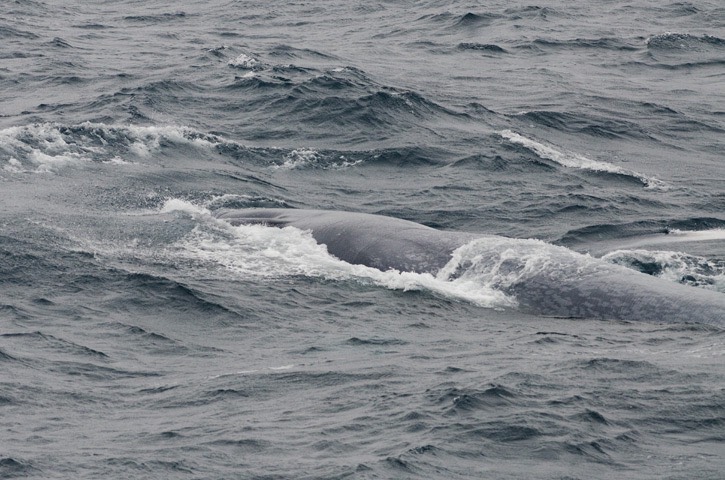
The whale then continued to swim alongside the ship less than two hundred metres away, much to the delight of a large number of crew members who had gathered on the bridge and at the bow to watch. During surfacings the large head and the massive blowholes of the whale were clearly visible.
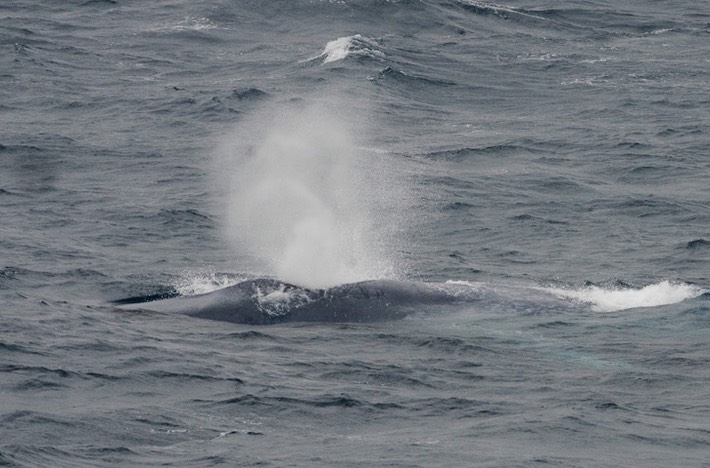
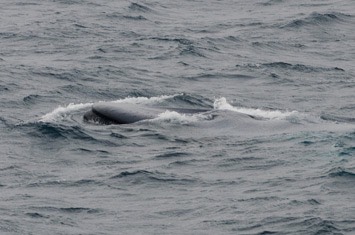
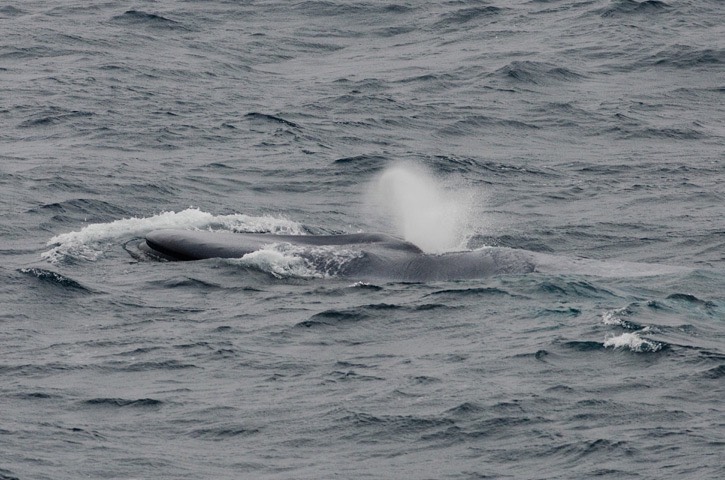
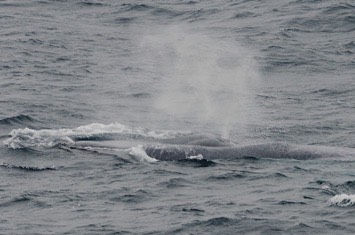
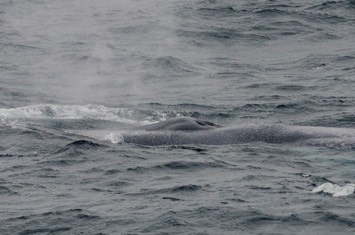

Some whale species habitually lift their flukes into the air before diving, while others never do so. In blue whales this behaviour varies between individuals. Some fluke before nearly every dive, while others never do. This whale, although only making shallow dives, did fluke up a couple of times, much to the delight of all the gathered whale watchers. The trailing edge of the fluke shows a row of attached sea creatures, which it may well have acquired while on its winter holidays in warmer waters.

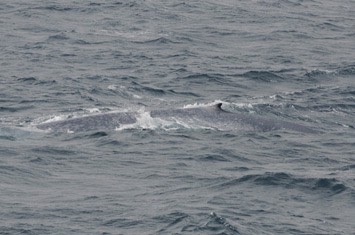
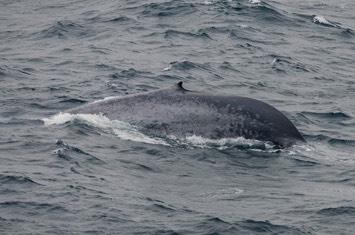
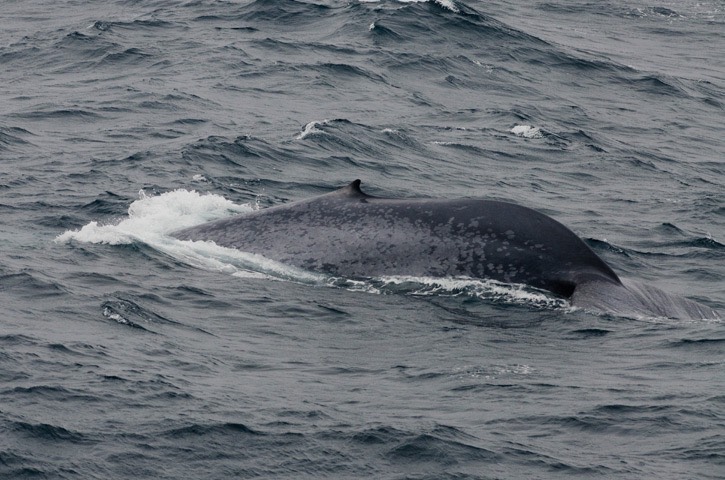
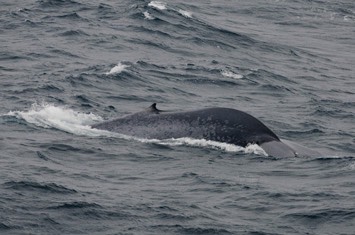
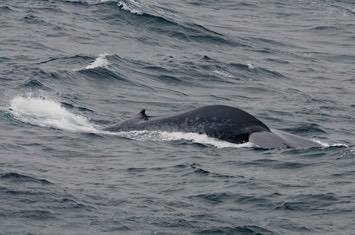
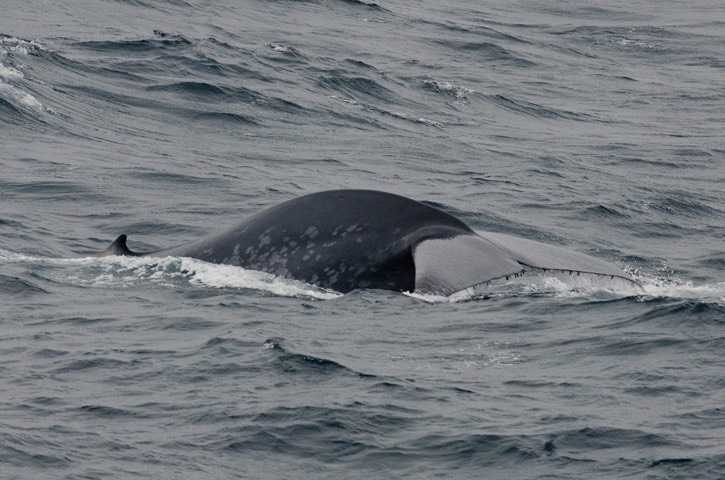
After a brief quiet spell, the whale suddenly accelerated, rushed away from the vessel and disappeared in the fog. Seeing such a huge animal propel its massive body at such speed was a very special sight indeed!
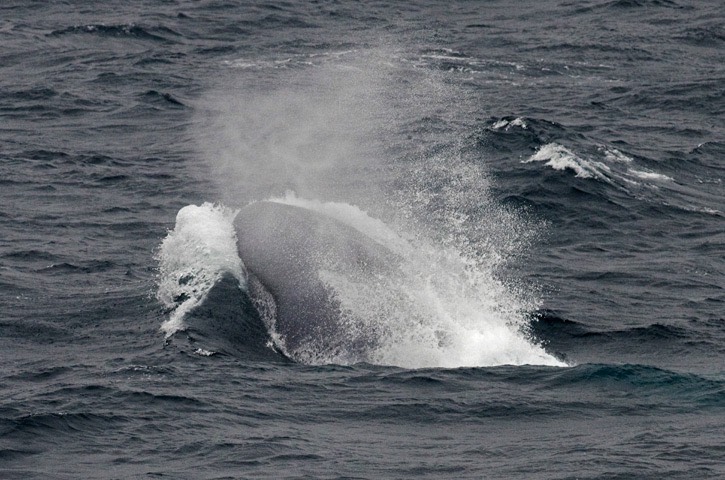
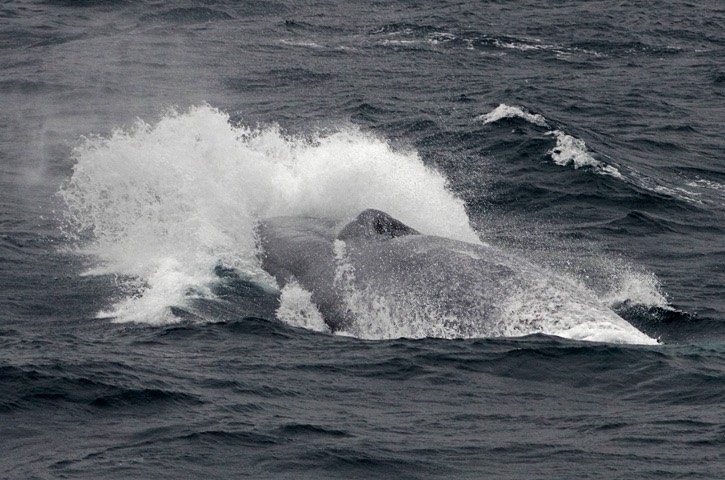
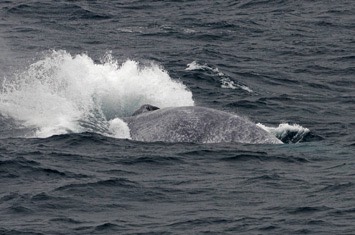
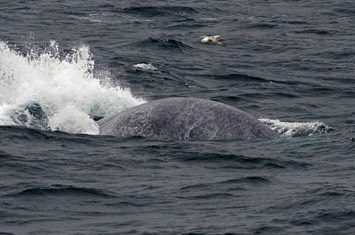
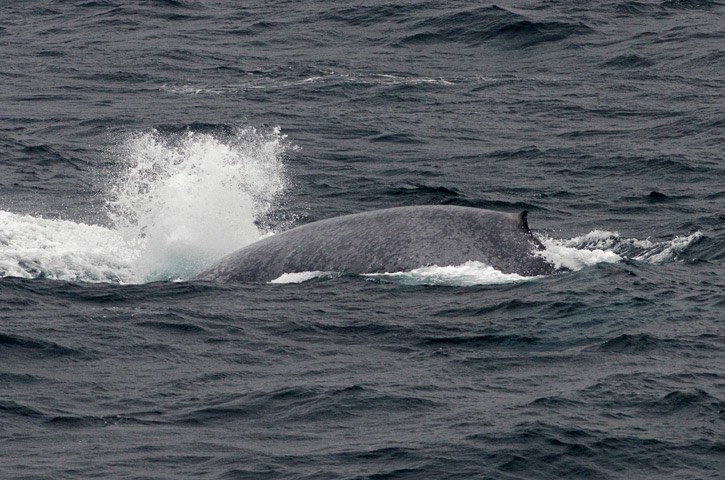
The last photo of the previous series also shows the pattern of this whale nicely, although for a good photo-identification image one ideally wants to take a photo square on the animal’s side. A photo-ID catalogue has been compiled for North Atlantic blue whales, run by Richard Sears of the Mingan Island Cetacean Study in Canada (http://www.rorqual.com/index.php). Richard collects photos from blue whales encountered all over the North Atlantic and hopes that he’ll be able to find out more about their migration routes between their high latitude feeding grounds and their more tropical wintering grounds. Recently, he and his team managed to find a match of a whale seen both in Iceland and Mauritania. However, none of our whales had apparently been photographed before and were therefore new additions to the catalogue. Although we had obviously hoped to come across a whale with a known history, having identified about a dozen new whales was a very important contribution to the current scientific knowledge of this mysterious species.
Not every fin breaking the surface belonged to a marine mammal; we also came across quite a number of sunfish (Mola mola) of all different sizes. The smallest we saw were in a shoal of five, each fish approximately 30 cm long, but we also came across several huge individuals of over a metre in size!
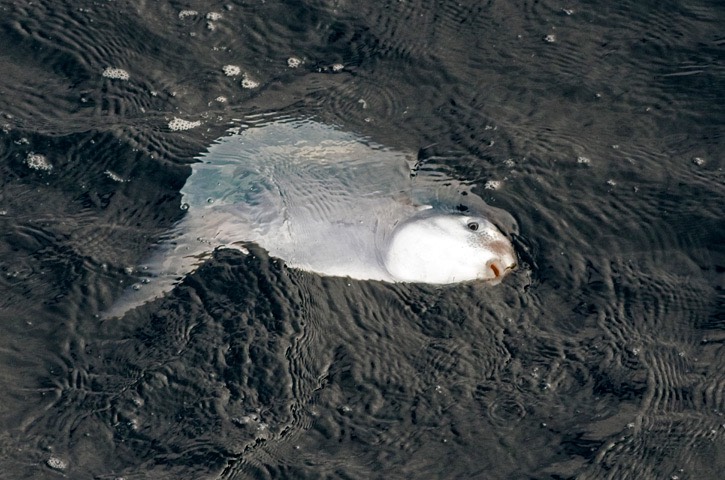
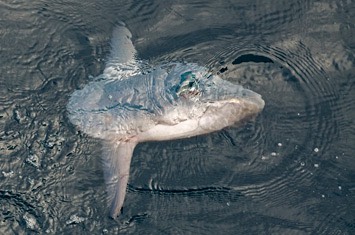
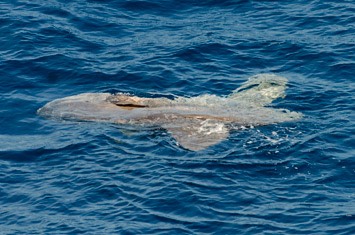
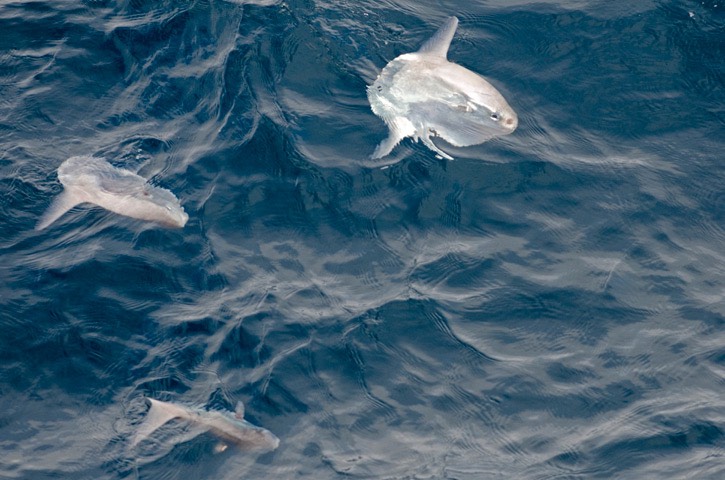
We managed to spot sharks only on glassy calm days. Those that we were able to photograph were most likely blue sharks (Prionace glauca), although we thought we also saw a distant much bigger fin of a basking shark.
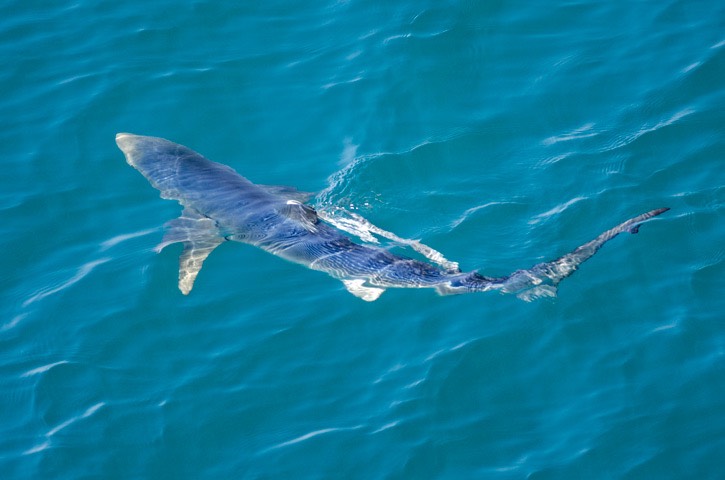
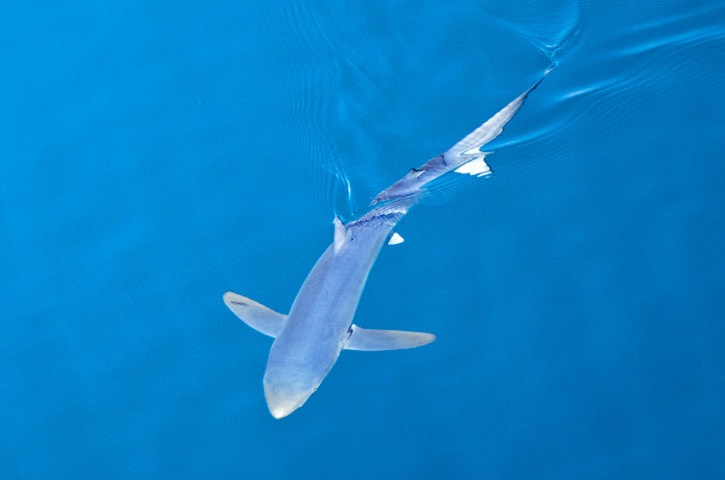
The most abundant bird species was the fulmar (Fulmarus glacialis), which was present nearly every day in quite large numbers.
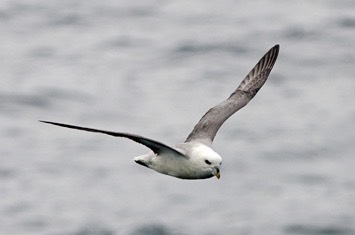
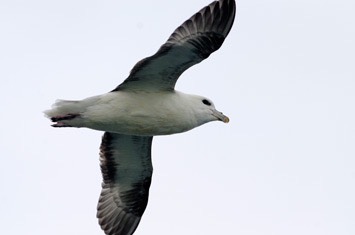
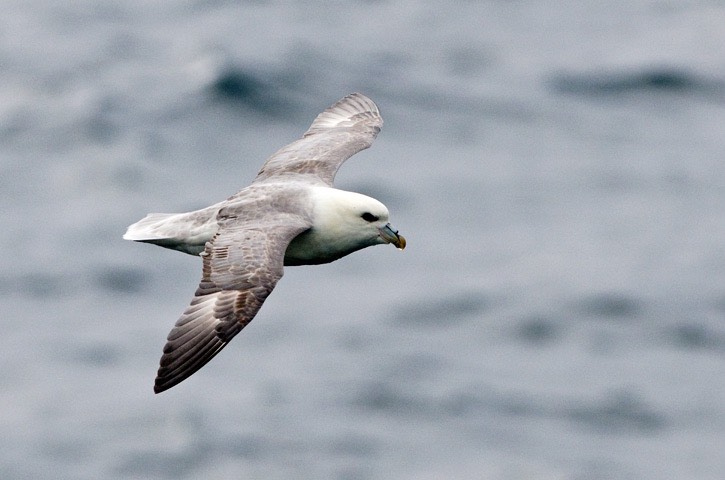
Gannets (Morus bassanus) were also seen on most days, although they didn’t approach the vessel very often. The bird in the photos was a curious youngster, approximately a year old.
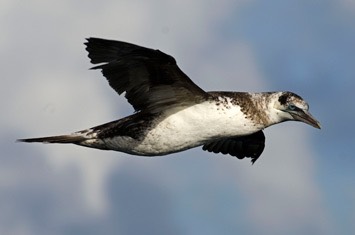
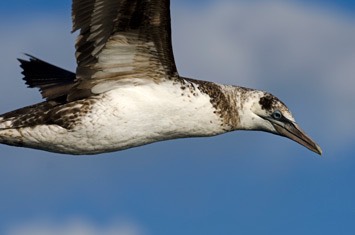
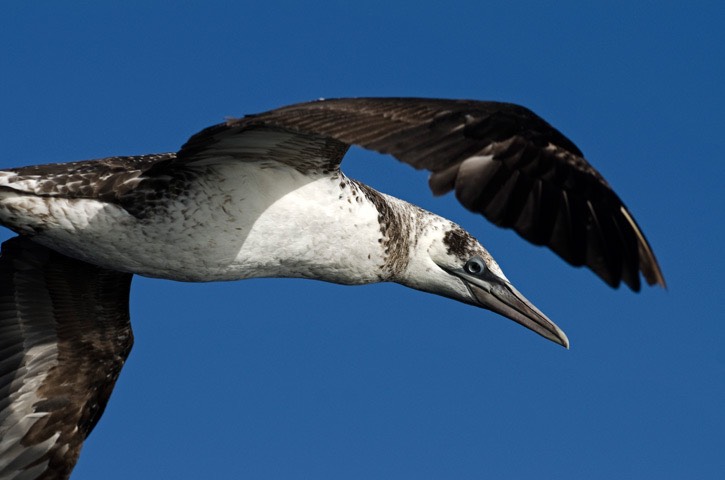
We recorded four different species of shearwater, but only got good photos of a sooty shearwater (Puffinus griseus).
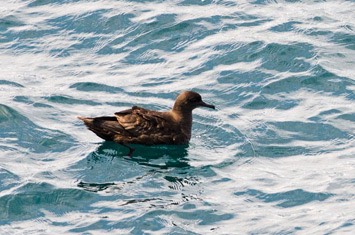
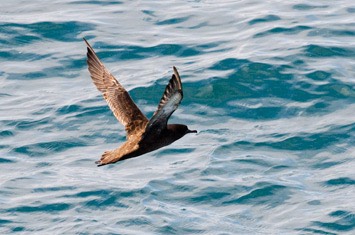
Lesser black-backed gulls (Larus fuscus) were the most frequently seen gull species, with this youngster taking a bit of a break on our ship.
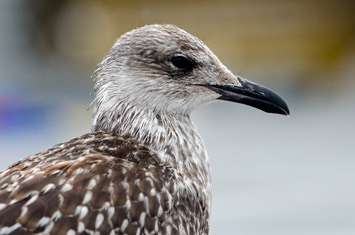
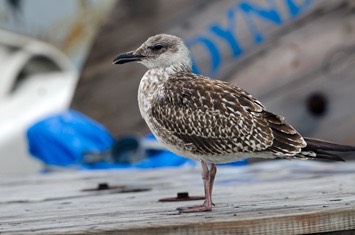
The autumn migration was under way and we were treated to a variety of migrant birds. The knot below checked all the puddles on our heli-deck for something edible - without much luck...
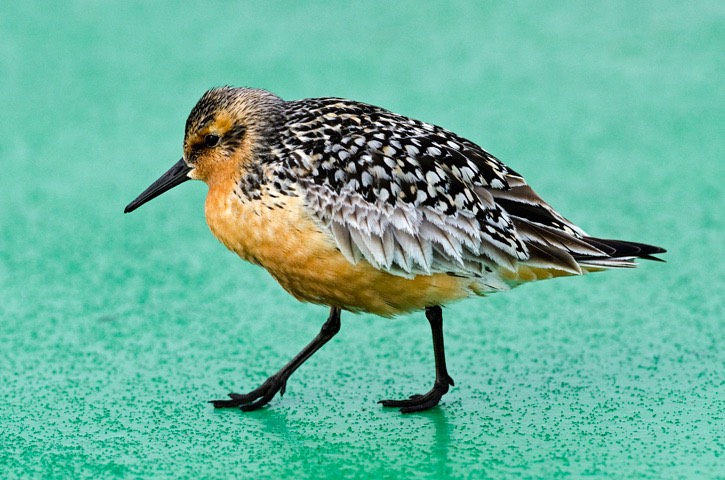
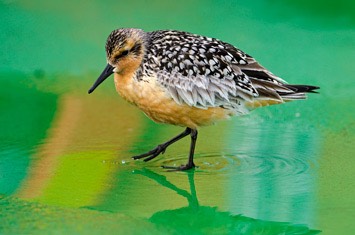
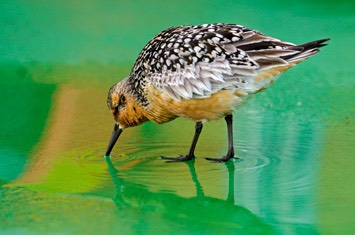
A hobby made our ship his temporary home. It first tried to catch any small bird that came past, but was obviously more successful with large hawk moths that couldn’t dodge its agile pursuit quite so easily.
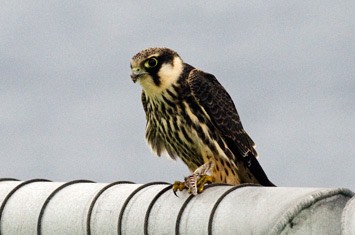
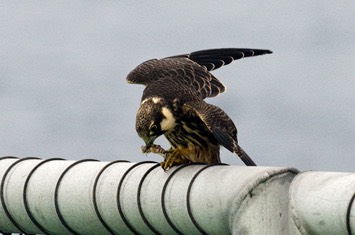
Land birds included the following: meadow pipits (top), lesser whitethroat (below left) and a crossbill (below right).
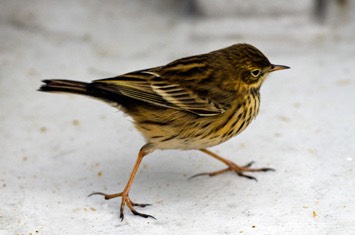
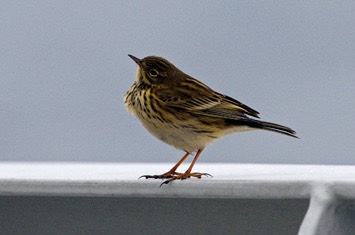
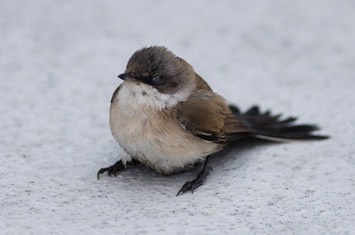
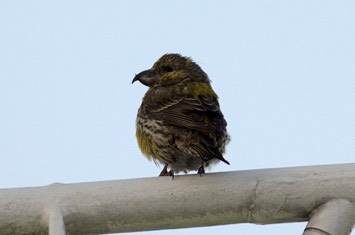
Wheatears stopped on the ship quite often. One young chap was more than happy to pose for us.
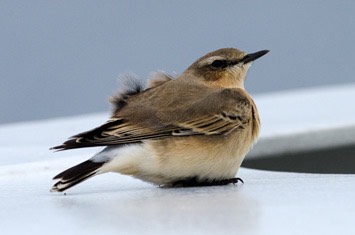
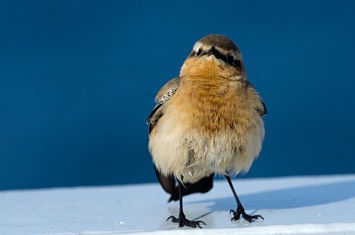
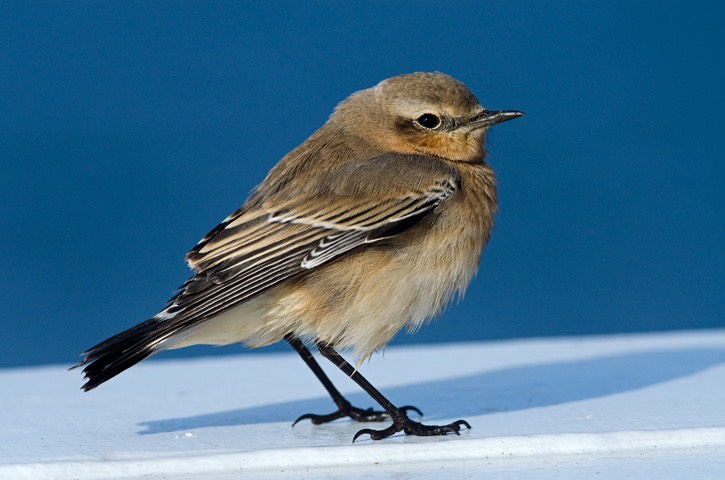
A wood pigeon (left) was a rather unusual visitor out at sea. One day we became the temporary staging post for a dozen or so racing pigeons. One stayed with us for weeks - the epic story of his incredible adventures can be found here.
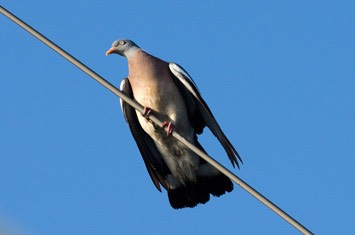
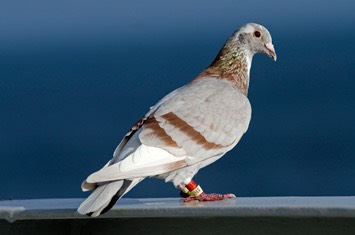
Another sort of bird came visiting three times - the Irish Maritime Air Corps plane did low fly-bys to check if we were behaving ourselves. They were so low we could see the pilot looking out of his window in the cockpit and another guy at a rear window taking photos of us taking photos of him.
